As a cat owner, it’s natural to wonder about the behaviors your furry friend displays towards you. You may have noticed actions like mounting or excessive affection and wondered if your cat is sexually attracted to you. However, it’s important to understand that these behaviors are driven by natural instincts and social behaviors within their own species, rather than a genuine sexual attraction to humans.
Cats have unique ways of expressing themselves, and sometimes their behaviors can be misunderstood. In this article, we will delve into the topic of feline sexual behavior, signs of affection, and how to maintain a healthy bond with your cat. By understanding your cat’s needs and behaviors, you can foster a strong and harmonious relationship.
Key Takeaways:
- Cats may exhibit behaviors that seem like sexual attraction towards humans, but it is important to understand that these actions are driven by natural instincts and social behaviors within their own species.
- Understanding feline sexual behavior can help differentiate it from misconceptions, preventing confusion and misinterpretation of your cat’s actions.
- Cats show affection through behaviors like purring, kneading, head-bumping, and gentle licking, indicating the bond they have with their owners.
- Building a strong bond and maintaining a consistent routine can help create a healthy and harmonious relationship with your cat, minimizing any problematic behaviors.
- Spaying or neutering your cat is crucial for controlling unwanted sexual behaviors and promoting their overall health.
Sexual Behavior in Cats
Understanding the sexual behavior of cats is essential for pet owners to differentiate between normal feline behavior and any misconstrued signals of sexual attraction towards humans. Male cats typically reach sexual maturity at around 12 weeks of age, while females reach puberty between 5-7 months. Male cats actively seek out females for mating, displaying behaviors such as yowling and roaming to find a suitable mate.
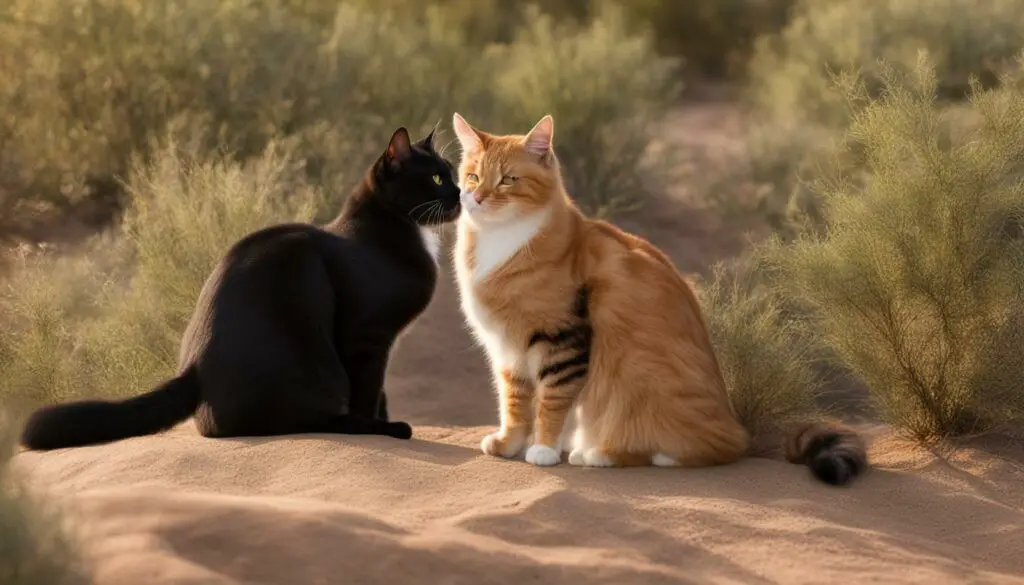
Females, on the other hand, become more flirtatious when in heat, which occurs approximately once every three weeks. During this time, they may exhibit behaviors such as increased vocalization, restlessness, and more affectionate behavior towards their owners. It is important to understand these natural mating behaviors to ensure the well-being of your cat and prevent any misinterpretation of their actions towards humans.
| Mating Behavior | Male Cats | Female Cats |
|---|---|---|
| Age of Sexual Maturity | Approximately 12 weeks | Between 5-7 months |
| Behavior Towards Mating | Actively seek out females | Flirtatious and receptive when in heat |
| Frequency of Heat Cycles | N/A | Approximately once every three weeks |
By understanding these mating behaviors, cat owners can provide appropriate care and attention to their pets, ensuring a healthy and harmonious relationship between cat and owner.
Signs of Affection in Cats
Cats are known for their unique ways of showing affection towards their owners. Understanding the signs of affection in cats can help strengthen the bond between you and your furry friend. Here are some common behaviors that indicate your cat’s love and affection:
- Purring: When a cat purrs, it is a clear sign of contentment and happiness. It is their way of expressing their affection towards you.
- Kneading: Kneading is the rhythmic movement of a cat’s paws against a soft surface. This behavior is often seen when a cat is feeling relaxed and comfortable, and it is a sign of trust and affection.
- Head-bumping: Cats often rub their heads against their owner’s legs, hands, or face. This behavior is a way for cats to mark you as part of their territory and is a sign of love and affection.
- Gentle licking: Cats may show their affection by grooming you with gentle licks. It is their way of showing trust and bonding with you.
Understanding these signs of affection can help you reciprocate and strengthen your bond with your cat. It is important to remember that each cat is unique, and their expressions of love may vary. Pay attention to your cat’s body language and behavior to identify their individual signs of affection.
Cats are independent, yet they show affection in their own special ways. By recognizing and appreciating their unique behaviors, we can nurture a strong bond with our feline companions.” – Unknown
Creating a nurturing and affectionate environment for your cat is essential for maintaining a healthy relationship. Make sure to provide plenty of love, attention, and interactive playtime to keep your cat happy and content. Remember, the best way to bond with your cat is to spend quality time together and respect their boundaries.
| Behavior | Sign of Affection |
|---|---|
| Purring | Contentment and happiness |
| Kneading | Trust and relaxation |
| Head-bumping | Marking you as part of their territory |
| Gentle licking | Showing trust and bonding |
Understanding Boundaries with Your Cat: Maintaining a Healthy Relationship
The bond between a cat and its owner is a unique and special relationship. To foster a healthy connection with your cat, it is essential to understand and respect their boundaries. Cats, like humans, have their preferences, comfort zones, and personal space. By recognizing and honoring these boundaries, you can create a harmonious and trusting relationship.
One aspect of respecting your cat’s boundaries is allowing them to approach you on their terms. Cats are independent animals and value their personal space. They appreciate it when their owners give them the freedom to decide when they want attention or affection. Avoid forcing interactions or invading their personal space without invitation. Instead, provide opportunities for your cat to approach you when they feel comfortable and ready.
Creating a calm and secure environment for your cat also helps establish healthy boundaries. Cats are sensitive to stress and changes in their surroundings. By maintaining a consistent and predictable routine, you can provide a sense of security and reduce anxiety for your feline friend. This includes sticking to regular feeding times, play sessions, and providing designated areas for rest and relaxation.
Respecting boundaries goes beyond physical space
Respecting your cat’s boundaries goes beyond physical space and also involves understanding their body language and communication cues. Cats communicate through a combination of vocalizations, body postures, and tail movements. By observing and interpreting these signals, you can better understand your cat’s needs and desires.
Avoid pushing your cat beyond their comfort zone or engaging in activities that they find stressful or overwhelming. Each cat has its own unique personality and preferences, and it is important to pay attention to their individual boundaries. Some cats may enjoy being held and cuddled, while others may prefer gentle strokes and quiet companionship.
Remember, maintaining a healthy relationship with your cat requires patience, empathy, and a willingness to adapt to their individual needs. By understanding and respecting their boundaries, you can create a strong bond built on trust and mutual respect.
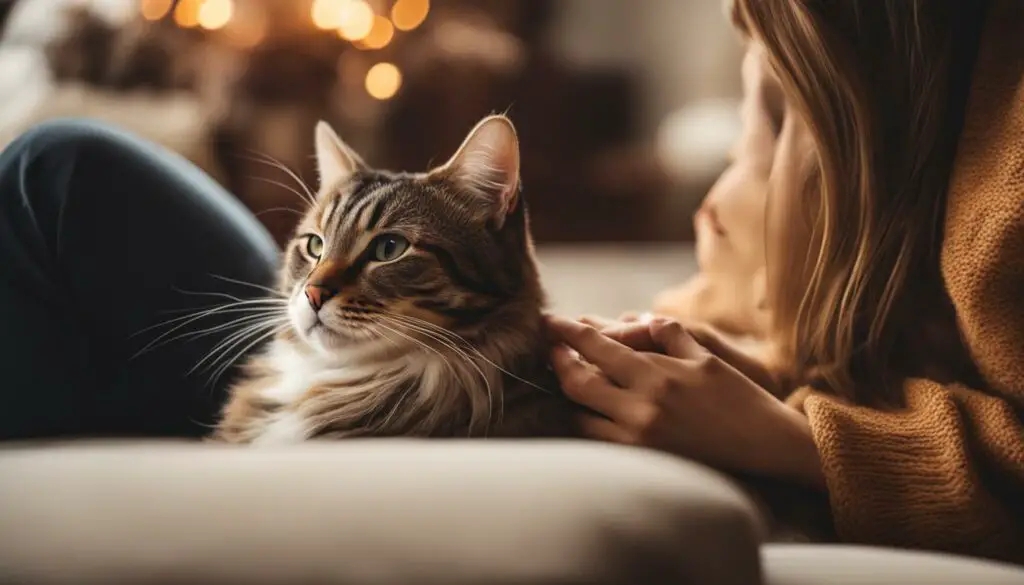
Table: Common Signs of a Cat’s Boundaries
| Sign | Meaning |
|---|---|
| Hissing or growling | An indication of fear or discomfort |
| Tail flicking | An expression of annoyance or agitation |
| Wide eyes and dilated pupils | A sign of fear or stress |
| Ear flattening | Indicates irritation or aggression |
| Turning away or avoiding eye contact | Desire for personal space |
Understanding and respecting your cat’s boundaries is essential for maintaining a healthy and fulfilling relationship. By providing them with the space, security, and attention they need, you can ensure a harmonious living environment and strengthen the bond between you and your feline companion.
Spaying or Neutering Your Cat
Spaying or neutering your cat is an essential step in controlling their sexual behaviors and promoting their overall health. These surgical procedures involve removing the reproductive organs of your cat, eliminating the urge to mate and reducing certain behaviors associated with mating instincts.
When a female cat, or queen, is spayed, her uterus and ovaries are removed, preventing her from going into heat and attracting male cats. This helps to prevent unwanted pregnancies and eliminates the risk of reproductive health issues, such as uterine infections and certain types of cancer.
Neutering a male cat, or tom, involves removing his testicles. This not only prevents him from impregnating female cats but also reduces behaviors like marking territory by spraying urine and engaging in aggressive or territorial fights with other cats.
Spaying or neutering your cat is an important responsible pet ownership decision. It helps control the cat population, reduces the risk of certain health complications, and can lead to a more well-behaved and contented pet.
If you’re unsure about the appropriate time to spay or neuter your cat, consult with your veterinarian. They will consider factors such as the cat’s age, health, and individual circumstances to determine the most suitable timing for the procedure. Remember, early spaying or neutering is recommended to prevent unwanted behaviors from developing.
Creating a Stimulating Environment
Providing a stimulating environment for your cat is essential to prevent behavioral issues and ensure their overall well-being. Cats are curious and intelligent animals that need mental and physical stimulation to thrive. By engaging their natural instincts and providing outlets for their energy, you can help keep your cat happy and content.
Cat Enrichment Ideas:
- Interactive Toys: Engage your cat with puzzle toys that dispense treats or toys with feathers and strings for them to chase.
- Climbing Structures: Install cat trees or shelves to allow your cat to climb and explore their environment.
- Scratching Posts: Provide multiple scratching posts to satisfy your cat’s instinct to scratch and keep their claws healthy.
- Hideouts: Create cozy spaces for your cat to retreat to, such as cat beds, tunnels, or cardboard boxes.
- Window Perches: Install window perches to give your cat a view of the outdoors and stimulate their hunting instincts.
“A stimulating environment with plenty of opportunities for play and exploration can help prevent boredom and destructive behaviors in cats.”
Remember to rotate toys and change the layout of their environment periodically to keep things interesting for your cat. By providing a variety of enrichment options, you can help prevent behavioral issues and create a happy and fulfilled feline companion.
| Enrichment Idea | Description | Benefits |
|---|---|---|
| Interactive Toys | Toys that require problem-solving and reward your cat’s effort | Stimulates mental agility and prevents boredom |
| Climbing Structures | Vertical spaces for climbing and perching | Allows cats to exercise and observe their surroundings |
| Scratching Posts | Surfaces for scratching and stretching | Helps maintain healthy claws and saves your furniture |
| Hideouts | Cozy spaces for napping and feeling safe | Provides a sense of security and relaxation |
| Window Perches | Platforms attached to windows for watching birds and outdoor activities | Stimulates natural hunting instincts and provides visual stimulation |
By implementing these enrichment ideas, you can create a stimulating environment that meets your cat’s physical, mental, and emotional needs. Remember to observe your cat’s preferences and adjust the enrichment options accordingly. With a well-balanced environment, you can help prevent behavioral issues and promote a happy and healthy life for your feline companion.
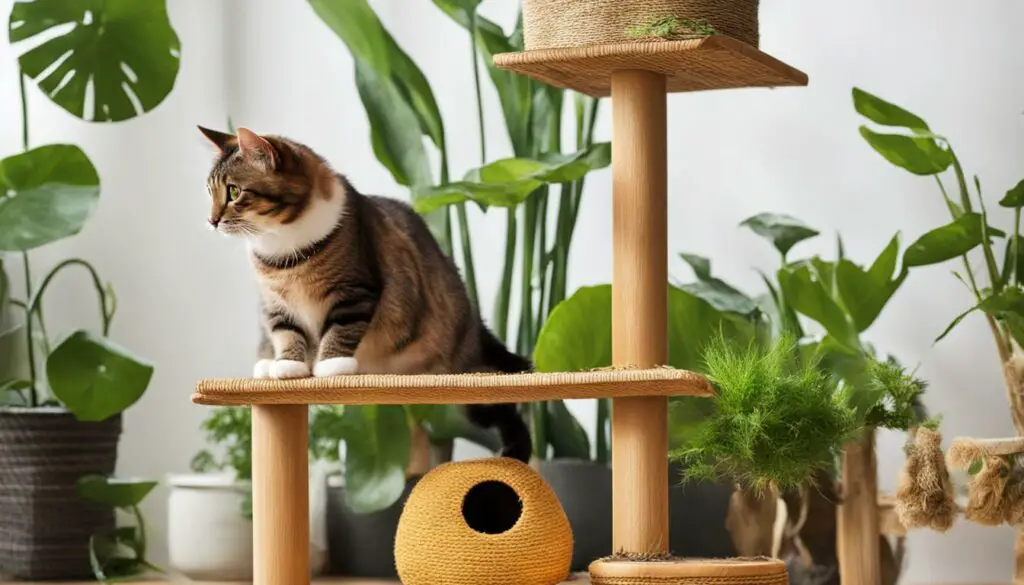
Maintaining a Consistent Routine
Establishing a consistent routine for your cat is essential for their overall well-being and happiness. Cats thrive on structure and predictability, and having a set schedule can help reduce stress and anxiety. By following a daily routine, you can fulfill their physical and mental needs, creating a harmonious environment for both you and your feline companion.
Here are some key aspects to consider when establishing a schedule for your cat:
- Feeding Times: Consistency in feeding schedules is crucial. Cats are creatures of habit, and having set meal times helps regulate their digestion and prevents overeating. It is recommended to feed your cat at the same time each day, dividing their meals into multiple smaller portions to mimic their natural hunting behavior.
- Playtime: Regular play sessions are essential for your cat’s physical and mental stimulation. Dedicate time each day for interactive play with toys, laser pointers, or feather wands. Engaging in play activities not only keeps your cat entertained but also helps strengthen the bond between you.
- Litter Box Maintenance: Cats are known for their cleanliness, so keeping their litter box clean is essential. Scoop the litter box at least once a day and replace the litter as needed. Placing the litter box in a quiet and accessible location ensures that your cat can maintain their bathroom routine comfortably.
- Sleep and Rest: Cats spend a significant portion of their day sleeping, so providing cozy and comfortable spaces for them to rest is crucial. Set up warm beds or blankets in quiet areas of your home where your cat can retreat and relax undisturbed.
Maintaining a consistent routine helps establish a sense of security for your cat and fosters a healthy cat-owner relationship. However, it’s important to remain flexible and adaptable to accommodate changes in your own schedule or unforeseen circumstances. Cats are highly intuitive and can adjust to minor deviations in their routine as long as they feel loved and cared for.
By following a consistent schedule, you can ensure that your cat’s needs are met, providing them with a happy and fulfilling life as part of your family.

Understanding Boundaries
Respecting your cat’s boundaries is an essential aspect of fostering a healthy and harmonious relationship. Just like humans, cats have their own preferences, personal space, and comfort zones. It is important to recognize and respect these boundaries to create an environment where your cat feels safe and secure.
One way to understand your cat’s boundaries is to observe their body language. For example, if your cat starts flicking their tail rapidly, flattens their ears, or hisses, these are clear signs that they want to be left alone. It is crucial not to force interaction during these moments and to give your cat the space they need.
Creating cozy spots and hiding places for your cat to retreat to when needed is also important. This can be a designated cat bed, a quiet corner with a soft blanket, or a cat tree with platforms where they can observe their surroundings from a safe distance. Providing these spaces allows your cat to have a sense of security and control over their environment.
Respecting boundaries also means:
- Avoiding sudden or loud movements that might startle your cat
- Not forcing physical contact or petting
- Allowing your cat to approach you on their terms
- Not disturbing your cat while they are eating or using the litter box
By understanding and respecting your cat’s boundaries, you can foster trust and build a strong relationship based on mutual respect. This will lead to a happier and healthier cat, and a more fulfilling experience as a cat owner.
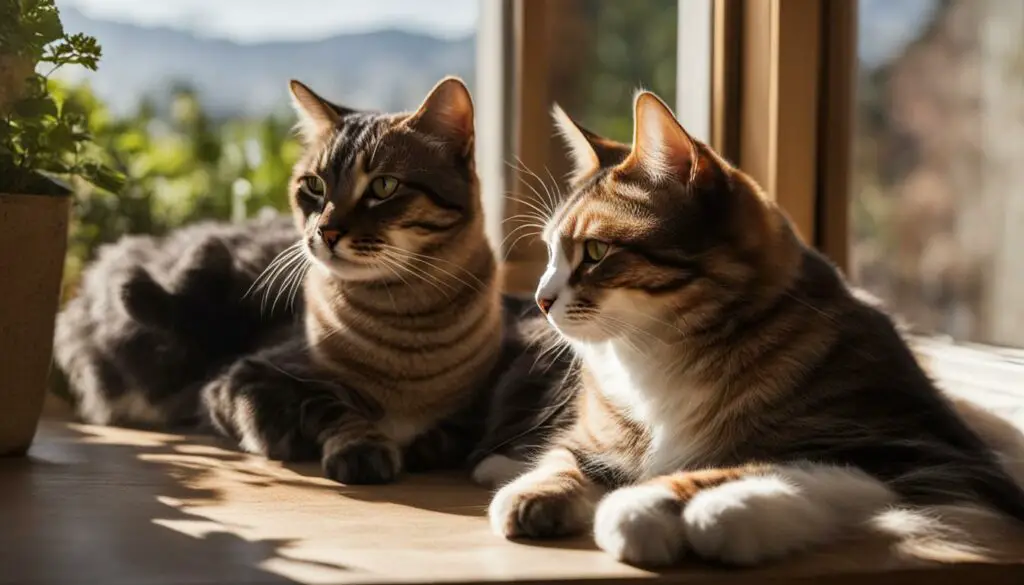
Seeking Professional Advice
When it comes to understanding cat behavior and addressing any challenges you may be facing, seeking professional advice is a valuable resource. Consulting a veterinarian or an animal behaviorist can provide you with expert guidance and insights into your cat’s behavior that you may not have considered. Their expertise can help you navigate any complex issues and find tailored solutions for your cat’s specific needs.
Veterinarians and animal behaviorists are equipped to evaluate your cat’s behavior, taking into account factors such as medical conditions, environmental stressors, and their individual personality. By thoroughly assessing these factors, they can provide you with a comprehensive understanding of your cat’s behavior and offer practical strategies to address any concerns.
Whether you’re dealing with aggression, litter box problems, excessive vocalization, or any other behavioral issues, consulting a professional can help you gain clarity and peace of mind. They can guide you in implementing behavior modification techniques, creating a cat-friendly environment, and establishing routines that will promote a healthy and harmonious relationship with your feline companion.
| Benefits of Seeking Professional Advice |
|---|
| Expert evaluation of your cat’s behavior |
| Identification of underlying medical conditions |
| Personalized strategies and solutions |
| Guidance in implementing behavior modification techniques |
| Support in creating a cat-friendly environment |
| Establishment of routines for a healthy relationship |
Myth or Truth: Can Cats Be Sexually Attracted to Humans?
There is a common misconception that cats can be sexually attracted to humans. However, this is not true. Cats are naturally inclined to exhibit certain behaviors that may be misinterpreted as sexual attraction. These behaviors, such as mounting or excessive affection, are driven by their natural instincts and social behaviors within their own species.
It is important to understand the normal sexual behavior of cats and differentiate it from misconceptions. Cats reach sexual maturity at different ages, with male cats actively seeking out females for mating. Female cats become more flirtatious when in heat, which occurs once every three weeks. These behaviors are part of their natural reproductive instincts and should not be mistaken as sexual attraction towards humans.
“Cats cannot have genuine sexual feelings towards humans, and their behaviors should be understood in the context of their natural instincts and social behaviors.” – Veterinarian Dr. Sarah Thompson
By debunking the myth that cats can be sexually attracted to humans, we can better understand and appreciate their behaviors. Cats show affection through actions like purring, kneading, head-bumping, and gentle licking. These displays of affection are indicative of the bond between a cat and its owner, rather than sexual attraction.
It is important to recognize and reciprocate these affectionate behaviors to nurture a strong bond with your cat. By providing love, attention, and a stimulating environment, you can create a positive and harmonious relationship with your feline companion.
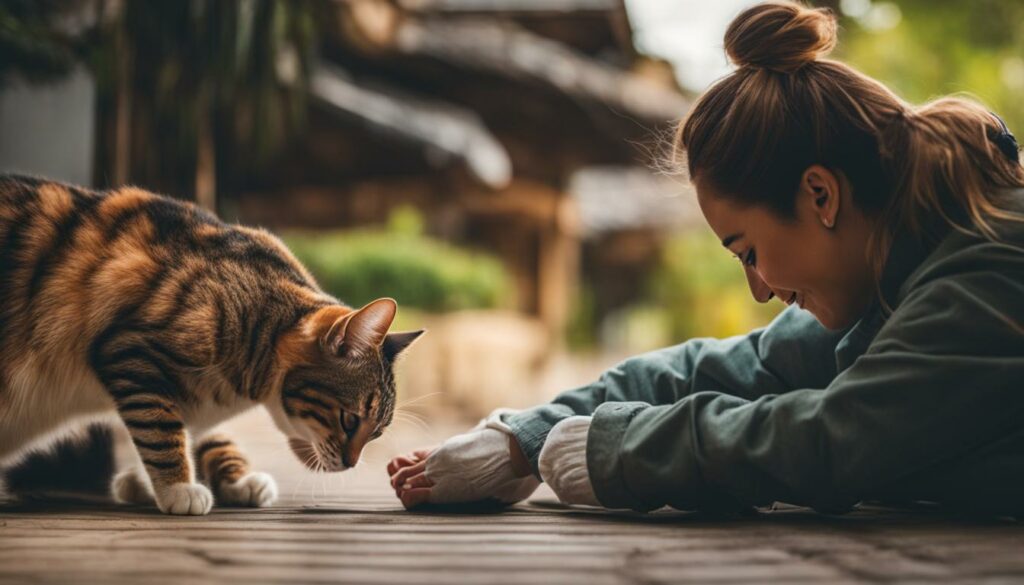
The Truth About Cat Behavior
There are many misconceptions surrounding cat behavior and it is important to separate fact from fiction. Cats cannot be sexually attracted to humans, and their behaviors are driven by natural instincts and social behaviors within their own species. Understanding these behaviors and providing the right care and environment can help foster a strong bond between you and your furry friend.
Signs That Your Cat Is in Heat
Recognizing when your cat is in heat is essential for providing appropriate care and understanding her behavior during this time. Cats display several signs that indicate they are in heat and seeking a mate. By being aware of these signs, you can ensure that your cat receives the necessary attention and support.
During heat, female cats may exhibit increased vocalization, restlessness, and more affectionate behavior towards their owners. They may rub against furniture, walls, or your legs more frequently. Additionally, you might notice excessive grooming, specifically around the genital area. Your cat may also display a strong desire to go outside and may try to escape or become more persistent in attempting to do so.
Understanding these signs can help you distinguish between typical behavior and heat-related behaviors. It’s important to provide extra care and attention to your cat during this time, ensuring she feels comfortable and secure. Creating a calm and safe environment can help alleviate any stress or discomfort associated with being in heat.
| Signs That Your Cat Is in Heat | Description |
|---|---|
| Increased Vocalization | Your cat may meow more frequently and more loudly than usual, seeking attention from potential mates. |
| Restlessness | Your cat may pace around the house, unable to settle down due to the urge to mate. |
| Affectionate Behavior | Your cat may become more affectionate towards you, seeking your attention and physical contact. |
| Excessive Grooming | Your cat may spend more time grooming herself, particularly around her genital area. |
| Desire to Go Outside | Your cat may become more insistent on going outside, attempting to escape to find a mate. |
It’s essential to keep your cat indoors during heat to prevent unwanted pregnancies and potential dangers associated with roaming. If you have an unaltered male cat at home, it’s crucial to separate them or ensure they cannot reach each other to avoid unwanted mating.
By recognizing the signs that your cat is in heat, you can provide the necessary care and attention she needs during this time. Understanding her behavior and creating a safe and calm environment will help alleviate any discomfort and ensure a harmonious living environment for both you and your cat.
Why Cats Are More Affectionate in Heat
During a cat’s heat cycle, also known as estrus, you may notice a significant increase in affectionate behavior towards you as their owner. This heightened display of affection is a result of their heightened reproductive instincts and the desire to seek a mate. While it may seem like your cat is suddenly smitten with you, it’s important to understand the underlying reasons behind this behavior.
One of the main factors contributing to increased affection in cats during heat is the release of hormones that drive their reproductive cycle. These hormones can cause your cat to seek more attention and physical contact with you. Additionally, cats in heat may exhibit behaviors such as rubbing against you, rolling around on the floor, and even vocalizing more frequently, all in an effort to attract a potential mate.
It’s crucial to remember that these behaviors are not indicative of genuine sexual attraction towards humans. Cats are highly instinctual creatures, and their actions during heat are driven by their biological urge to reproduce. Understanding this can help you respond appropriately and provide comfort to your cat during this time.
To support your cat during heat, ensure they have a calm and secure environment, offer plenty of play and exercise to release pent-up energy, and provide them with extra attention and affection. If your cat’s behavior becomes overly intrusive or bothersome, consulting with a veterinarian can provide valuable insights and guidance on managing their behavior.
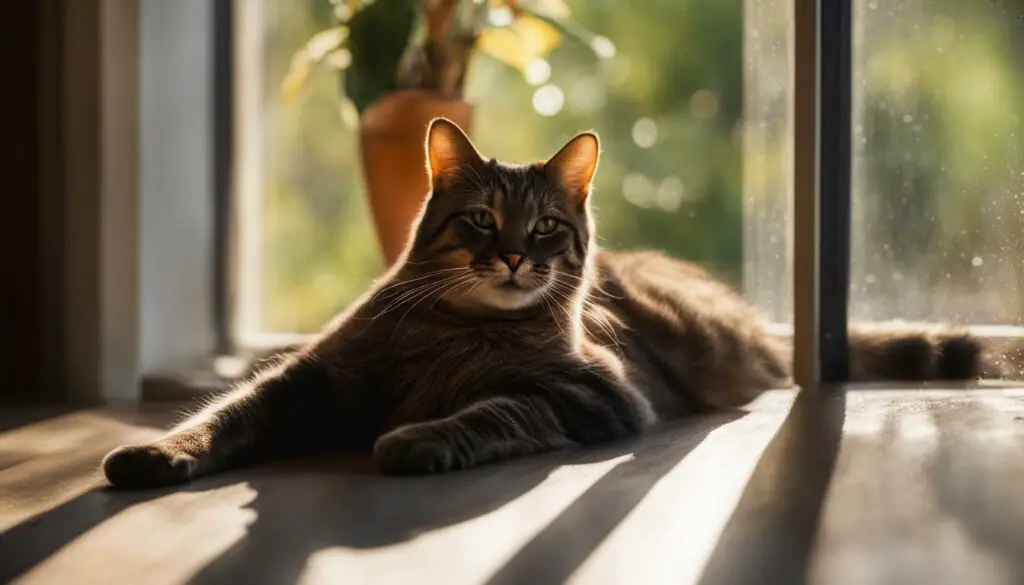
Table: Common Affectionate Behaviors in Cats During Heat
| Behavior | Description |
|---|---|
| Rubbing against you | Your cat may rub their body against your legs, furniture, or other objects as a way to mark their territory and seek attention. |
| Rolling around | Cats in heat may roll around on the floor, displaying playful behavior and attempting to capture your attention. |
| Purring | One of the most common signs of affection in cats, purring can intensify during heat as your cat seeks comfort and connection. |
| Vocalizing | Cats in heat may vocalize more frequently, using meows and other sounds to communicate their availability to potential mates. |
| Increased physical contact | Your cat may seek more physical contact with you, such as crawling in your lap or snuggling up against you as a way to seek warmth and comfort. |
Things to Do When Your Cat Is in Heat
When your cat is in heat, it’s important to provide extra care and attention to help manage their behavior and ensure their comfort. Here are some strategies to consider:
- Offer physical attention: Your cat may seek more physical contact during heat. Providing gentle petting and cuddling can help alleviate their stress and make them feel more secure.
- Distract with play: Engaging your cat in interactive play sessions can help redirect their energy and focus away from their heat behavior. Use toys that stimulate their hunting instincts to keep them entertained.
- Consult with your vet: Your veterinarian can offer guidance on medication options to help manage your cat’s heat behavior. They may recommend hormonal treatments or other medications to help alleviate discomfort and reduce the intensity of your cat’s heat symptoms.
- Create a calm environment: Ensure your cat has a quiet and comfortable space where they can relax and feel safe. Provide cozy bedding and create a soothing atmosphere to help minimize any stress or anxiety your cat may experience.
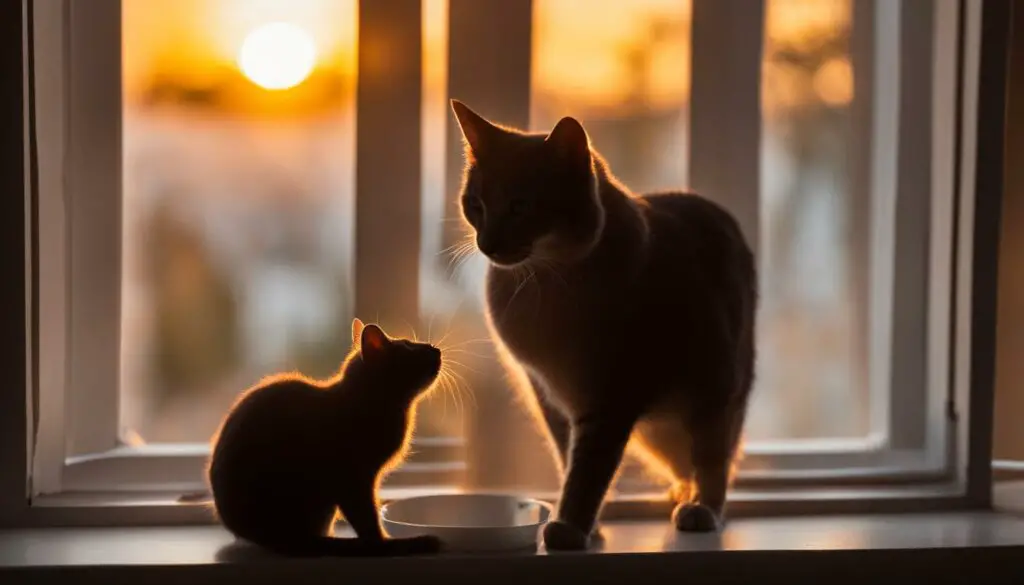
By implementing these strategies, you can help care for your cat during their heat cycle and provide them with the support they need to feel more comfortable. Remember, it’s crucial to consult with your veterinarian for personalized advice and to address any concerns you may have regarding your cat’s behavior during heat.
Is My Cat Under Pain When She Is in Heat?
Understanding the level of pain or discomfort that cats experience during heat is still uncertain. While some cats may show signs of distress or discomfort, others may appear relatively unaffected. As a responsible cat owner, it is essential to take precautions and provide extra attention and care during this time to help alleviate any potential discomfort and reduce stress for your cat.
During heat, cats may exhibit behaviors such as restlessness, increased vocalization, excessive grooming, and a desire to go outside. These signs indicate that your cat is in heat and seeking a mate. While it’s difficult to determine the exact level of pain, providing a calm and comfortable environment, offering additional physical attention, and consulting with your vet for possible medication options can help address any discomfort your cat may be experiencing.
Just like humans, cats may experience some discomfort during heat. However, it is important to remember that this is a natural part of their reproductive cycle and should not be confused with genuine pain or suffering. By providing the right care and attention, you can help your cat navigate this period more comfortably.
Always keep a close eye on your cat’s behavior during heat. If you notice any concerning symptoms, such as excessive crying, refusal to eat or drink, or any unusual behavior, it is best to consult with your veterinarian. They can evaluate your cat’s overall health and provide guidance on how to ensure their well-being during this time.
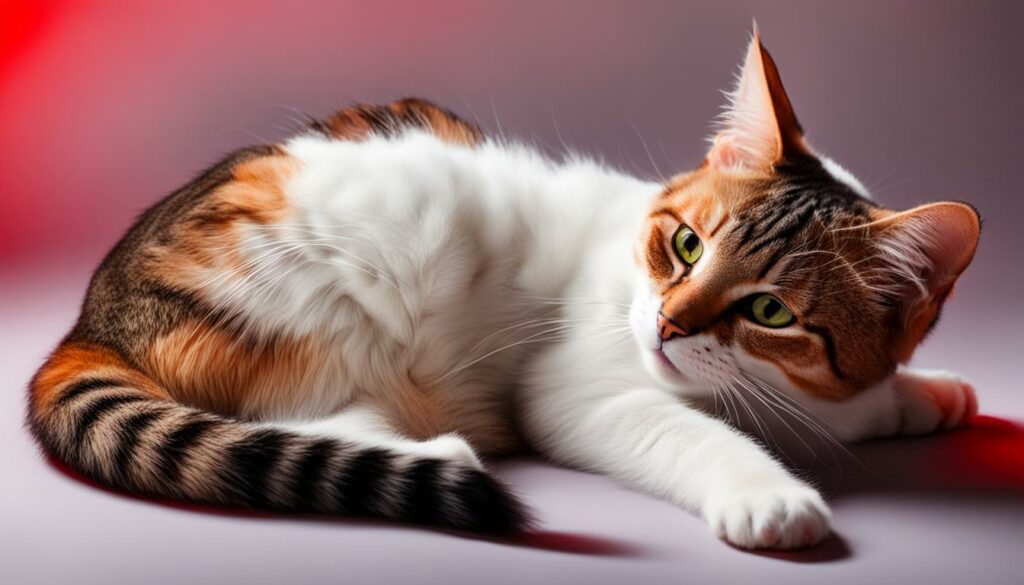
Does a Male Cat Mount on a Female Cat Not in Heat?
Understanding male cat mating behavior is essential for cat owners to differentiate between natural instincts and misconstrued signals. It is not uncommon for a male cat to mount a female cat even when she is not in heat. This behavior is driven by the male cat’s instinctual drive to mate and establish dominance rather than a genuine sexual attraction to the female cat. It is crucial to comprehend the reasons behind this behavior and take appropriate measures to address it.
Male cats, especially those that are not neutered, may exhibit mounting behavior as a means of asserting their dominance and establishing hierarchy within their territory. This behavior can occur regardless of whether the female cat is receptive to mating or not. Neutering can help reduce this behavior by minimizing the male cat’s hormone-driven instincts. However, it is important to remember that mounting can still occur due to territorial reasons or social cues within a multi-cat household.
To address mounting behavior, it is advisable to consider neutering your male cat. Neutering can not only reduce mounting but also prevent unwanted behaviors associated with mating instincts, such as spraying and aggression. Consulting with a veterinarian is crucial to determine the appropriate time for neutering and to discuss any concerns or questions you may have regarding your male cat’s behavior.
Creating a stimulating environment for your male cat, including providing plenty of toys, scratching posts, and opportunities for play, can also help redirect their energy and prevent mounting behavior. Additionally, keeping a consistent routine, maintaining boundaries, and providing positive reinforcement for desired behaviors can contribute to a harmonious relationship with your male cat.
| Pros | Cons |
|---|---|
| Neutering can reduce mounting behavior | Mounting can still occur due to territorial reasons or social cues |
| Prevents unwanted behaviors associated with mating instincts | Consulting with a veterinarian is required for the appropriate timing of neutering |
| Creating a stimulating environment can redirect energy | Requires consistent routine and positive reinforcement for desired behaviors |
Conclusion
In understanding feline behavior, it is crucial to debunk common misconceptions and maintain a healthy cat-owner relationship. Cats cannot be sexually attracted to humans; their behaviors should be viewed through the lens of their natural instincts and social behaviors. By providing the right care, a stimulating environment, and respecting boundaries, we can nurture a strong bond with our cats and create a positive living environment for both of us.
Maintaining a healthy cat-owner relationship involves recognizing and reciprocating affectionate gestures, understanding the signs of heat in female cats, and addressing the behavioral needs of our furry companions. Cats thrive on routine and predictability, so establishing consistent schedules for feeding, playtime, and other activities is essential. By doing so, we fulfill their physical and mental needs, reducing stress and anxiety.
Creating a stimulating environment with toys, scratching posts, and interactive play helps keep our cats mentally and physically engaged, preventing boredom and destructive behaviors. Building trust and respecting our cat’s boundaries is also crucial. Recognizing when they need solitude and providing cozy spots for retreat promotes a sense of security and strengthens the bond between us.
If challenges arise in our relationship with our cat, seeking professional advice from a veterinarian or animal behaviorist is not a failure. These experts can evaluate our cat’s behavior, identify underlying medical conditions, and provide tailored guidance to address challenges and find solutions. Understanding feline behavior and maintaining a healthy cat-owner relationship ultimately leads to a harmonious and fulfilling companionship.
FAQ
Is my cat sexually attracted to me?
No, cats cannot have genuine sexual feelings towards humans. Their behaviors should be understood in the context of their natural instincts and social behaviors.
What are the signs of affection in cats?
Cats show affection through behaviors like purring, kneading, head-bumping, and gentle licking. These actions are indicative of the bond between a cat and its owner.
How can I build a strong bond with my cat?
Building a strong bond with your cat involves positive interactions, consistent routines, and understanding their boundaries. Cats are highly sensitive to their environment and the emotional state of their owners.
Should I spay or neuter my cat?
Yes, spaying or neutering your cat is crucial for controlling unwanted sexual behaviors and promoting their overall health. These procedures help reduce spraying, yowling, and aggressive behaviors associated with mating instincts.
How can I create a stimulating environment for my cat?
Providing toys, scratching posts, and interactive play helps keep your cat mentally and physically engaged. Cats are natural hunters, and allowing them to engage in their instinctual behaviors prevents boredom and destructive behaviors.
Why is maintaining a consistent routine important for cats?
Cats thrive on routine and predictability. Establishing a consistent schedule for feeding, playtime, and other activities fulfills their physical and mental needs, reducing stress and anxiety.
How can I understand and respect my cat’s boundaries?
Recognize when your cat wants solitude and allow it to approach you on its own terms. Providing cozy spots and hiding places for your cat to retreat to when needed promotes a sense of security.
What should I do if I encounter difficulties with my cat’s behavior?
Seeking professional advice from veterinarians and animal behaviorists is not a failure. They can evaluate your cat’s behavior, identify underlying medical conditions, and provide guidance on modification techniques.
Can cats be sexually attracted to humans?
No, cats cannot be sexually attracted to humans. It is important to address the misconceptions surrounding this topic and understand the natural instincts and social behaviors of cats.
How can I recognize if my cat is in heat?
Signs of a cat in heat include increased vocalization, restlessness, more affectionate behavior, excessive grooming, and a desire to go outside.
Why are cats more affectionate during heat?
Cats are more affectionate during heat due to their heightened reproductive instincts and the desire to seek a mate. They may display increased affection and seek more attention from their owners.
What can I do when my cat is in heat?
Providing extra physical attention, distracting them with play, consulting with your vet for medication options, creating a calm environment, and considering a service teaser tom cat can help alleviate stress and discomfort for your cat during heat.
Is my cat in pain when she is in heat?
The level of pain or discomfort a cat may experience during heat is uncertain. However, taking precautions and providing extra attention and care during this time can help alleviate any potential discomfort and reduce stress for your cat.
Does a male cat mount on a female cat not in heat?
Yes, a male cat may exhibit mounting behavior even when females are not in heat. Neutering can help reduce this behavior, but it’s important to understand that mounting is driven by natural instincts rather than genuine sexual attraction to the female cat.
How can I maintain a healthy cat-owner relationship?
Understanding feline behavior, providing the right care and environment, and respecting boundaries can help maintain a healthy and harmonious relationship with your cat.








